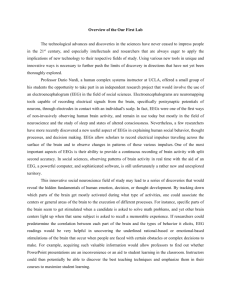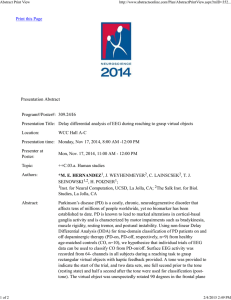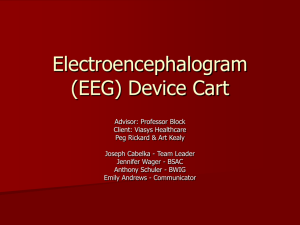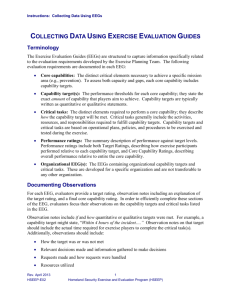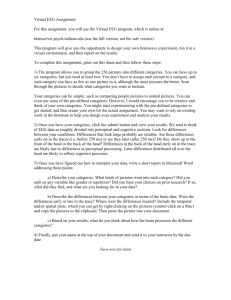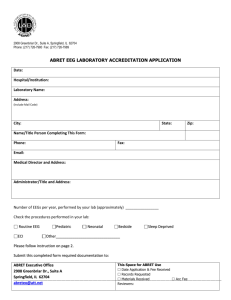poster_4_v00
advertisement
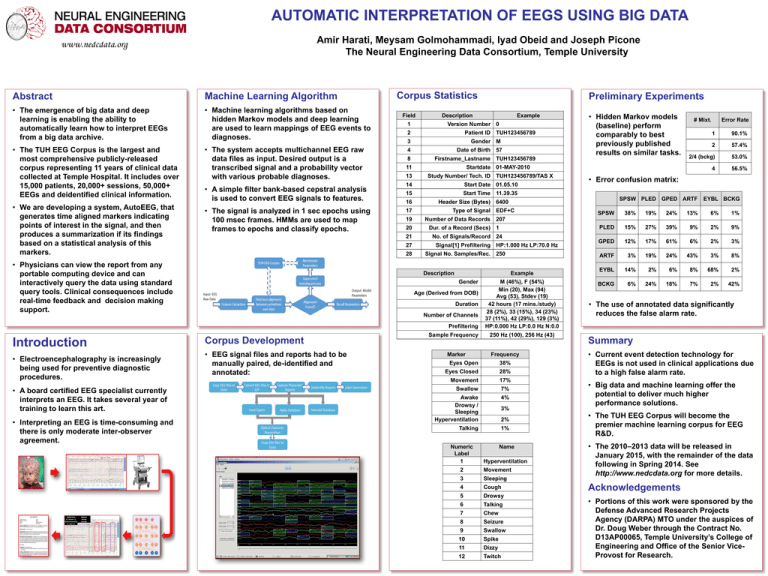
AUTOMATIC INTERPRETATION OF EEGS USING BIG DATA Amir Harati, Meysam Golmohammadi, Iyad Obeid and Joseph Picone The Neural Engineering Data Consortium, Temple University www.nedcdata.org Abstract Machine Learning Algorithm • The emergence of big data and deep learning is enabling the ability to automatically learn how to interpret EEGs from a big data archive. • Machine learning algorithms based on hidden Markov models and deep learning are used to learn mappings of EEG events to diagnoses. • The TUH EEG Corpus is the largest and most comprehensive publicly-released corpus representing 11 years of clinical data collected at Temple Hospital. It includes over 15,000 patients, 20,000+ sessions, 50,000+ EEGs and deidentified clinical information. • We are developing a system, AutoEEG, that generates time aligned markers indicating points of interest in the signal, and then produces a summarization if its findings based on a statistical analysis of this markers. • The system accepts multichannel EEG raw data files as input. Desired output is a transcribed signal and a probability vector with various probable diagnoses. Corpus Statistics Field 1 Description Version Number 0 2 Patient ID TUH123456789 3 Gender M 4 Date of Birth 57 8 Firstname_Lastname TUH123456789 11 Study Number/ Tech. ID TUH123456789/TAS X • A simple filter bank-based cepstral analysis is used to convert EEG signals to features. 14 Start Date 01.05.10 15 Start Time 11.39.35 • The signal is analyzed in 1 sec epochs using 100 msec frames. HMMs are used to map frames to epochs and classify epochs. 17 16 20 Dur. of a Record (Secs) 1 28 No. of Signals/Record 24 Signal[1] Prefiltering HP:1.000 Hz LP:70.0 Hz Signal No. Samples/Rec. 250 Description Example Gender Age (Derived from DOB) Duration Number of Channels • A board certified EEG specialist currently interprets an EEG. It takes several year of training to learn this art. • Interpreting an EEG is time-consuming and there is only moderate inter-observer agreement. Corpus Development • EEG signal files and reports had to be manually paired, de-identified and annotated: Sample Frequency Marker M (46%), F (54%) Min (20), Max (94) Avg (53), Stdev (19) 42 hours (17 mins./study) 28 (2%), 33 (15%), 34 (23%) 37 (11%), 42 (29%), 129 (3%) HP:0.000 Hz LP:0.0 Hz N:0.0 250 Hz (100), 256 Hz (43) Frequency Eyes Open 38% Eyes Closed 28% Movement 17% Swallow 7% Awake Drowsy / Sleeping Hyperventilation 4% Talking 1% Numeric Label 1 3% 2% Name Hyperventilation 2 Movement 3 Sleeping 4 Cough 5 Drowsy 6 Talking 7 Chew 8 Seizure 9 Swallow 10 Spike 11 Dizzy 12 Twitch Error Rate 1 90.1% 2 57.4% 2/4 (bckg) 53.0% 4 56.5% SPSW PLED GPED ARTF Type of Signal EDF+C Number of Data Records 207 27 # Mixt. • Error confusion matrix: Header Size (Bytes) 6400 19 21 • Hidden Markov models (baseline) perform comparably to best previously published results on similar tasks. Startdate 01-MAY-2010 Prefiltering • Electroencephalography is increasingly being used for preventive diagnostic procedures. Example 13 • Physicians can view the report from any portable computing device and can interactively query the data using standard query tools. Clinical consequences include real-time feedback and decision making support. Introduction Preliminary Experiments EYBL BCKG SPSW 38% 19% 24% 13% 6% 1% PLED 15% 27% 39% 9% 2% 9% GPED 12% 17% 61% 6% 2% 3% ARTF 3% 19% 24% 43% 3% 8% EYBL 14% 2% 6% 8% 68% 2% BCKG 6% 24% 18% 7% 2% 42% • The use of annotated data significantly reduces the false alarm rate. Summary • Current event detection technology for EEGs is not used in clinical applications due to a high false alarm rate. • Big data and machine learning offer the potential to deliver much higher performance solutions. • The TUH EEG Corpus will become the premier machine learning corpus for EEG R&D. • The 2010–2013 data will be released in January 2015, with the remainder of the data following in Spring 2014. See http://www.nedcdata.org for more details. Acknowledgements • Portions of this work were sponsored by the Defense Advanced Research Projects Agency (DARPA) MTO under the auspices of Dr. Doug Weber through the Contract No. D13AP00065, Temple University’s College of Engineering and Office of the Senior ViceProvost for Research.


